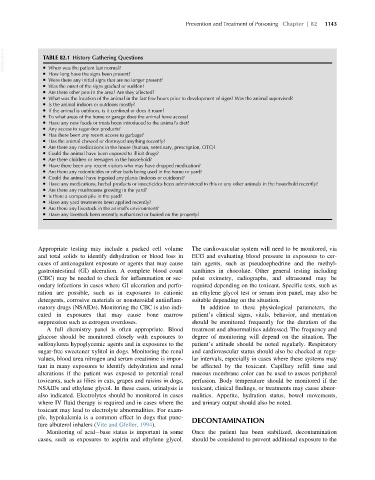Page 1212 - Veterinary Toxicology, Basic and Clinical Principles, 3rd Edition
P. 1212
Prevention and Treatment of Poisoning Chapter | 82 1143
VetBooks.ir TABLE 82.1 History Gathering Questions
When was the patient last normal?
How long have the signs been present?
Were there any initial signs that are no longer present?
Was the onset of the signs gradual or sudden?
Are there other pets in the area? Are they affected?
What was the location of the animal in the last few hours prior to development of signs? Was the animal supervised?
Is the animal indoors or outdoors mostly?
If the animal is outdoors, is it confined or does it roam?
To what areas of the home or garage does the animal have access?
Have any new foods or treats been introduced to the animal’s diet?
Any access to sugar-free products?
Has there been any recent access to garbage?
Has the animal chewed or destroyed anything recently?
Are there any medications in the house (human, veterinary, prescription, OTC)?
Could the animal have been exposed to illicit drugs?
Are there children or teenagers in the household?
Have there been any recent visitors who may have dropped medication?
Are there any rodenticides or other baits being used in the home or yard?
Could the animal have ingested any plants (indoors or outdoors)?
Have any medications, herbal products or insecticides been administered to this or any other animals in the household recently?
Are there any mushrooms growing in the yard?
Is there a compost pile in the yard?
Have any yard treatments been applied recently?
Are there any livestock in the animal’s environment?
Have any livestock been recently euthanized or buried on the property?
Appropriate testing may include a packed cell volume The cardiovascular system will need to be monitored, via
and total solids to identify dehydration or blood loss in ECG and evaluating blood pressure in exposures to cer-
cases of anticoagulant exposure or agents that may cause tain agents, such as pseudoephedrine and the methyl-
gastrointestinal (GI) ulceration. A complete blood count xanthines in chocolate. Other general testing including
(CBC) may be needed to check for inflammation or sec- pulse oximetry, radiographs, and ultrasound may be
ondary infections in cases where GI ulceration and perfo- required depending on the toxicant. Specific tests, such as
ration are possible, such as in exposures to cationic an ethylene glycol test or serum iron panel, may also be
detergents, corrosive materials or nonsteroidal antiinflam- suitable depending on the situation.
matory drugs (NSAIDs). Monitoring the CBC is also indi- In addition to these physiological parameters, the
cated in exposures that may cause bone marrow patient’s clinical signs, vitals, behavior, and mentation
suppression such as estrogen overdoses. should be monitored frequently for the duration of the
A full chemistry panel is often appropriate. Blood treatment and abnormalities addressed. The frequency and
glucose should be monitored closely with exposures to degree of monitoring will depend on the situation. The
sulfonylurea hypoglycemic agents and in exposures to the patient’s attitude should be noted regularly. Respiratory
sugar-free sweetener xylitol in dogs. Monitoring the renal and cardiovascular status should also be checked at regu-
values, blood urea nitrogen and serum creatinine is impor- lar intervals, especially in cases where these systems may
tant in many exposures to identify dehydration and renal be affected by the toxicant. Capillary refill time and
alterations if the patient was exposed to potential renal mucous membrane color can be used to assess peripheral
toxicants, such as lilies in cats, grapes and raisins in dogs, perfusion. Body temperature should be monitored if the
NSAIDs and ethylene glycol. In these cases, urinalysis is toxicant, clinical findings, or treatments may cause abnor-
also indicated. Electrolytes should be monitored in cases malities. Appetite, hydration status, bowel movements,
where IV fluid therapy is required and in cases where the and urinary output should also be noted.
toxicant may lead to electrolyte abnormalities. For exam-
ple, hypokalemia is a common effect in dogs that punc- DECONTAMINATION
ture albuterol inhalers (Vite and Gfeller, 1994).
Monitoring of acid base status is important in some Once the patient has been stabilized, decontamination
cases, such as exposures to aspirin and ethylene glycol. should be considered to prevent additional exposure to the

